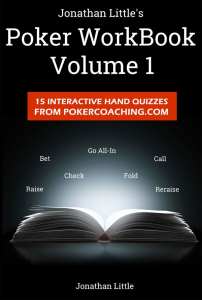 I recently released The Poker Workbook: Volume 1, the first in my series of books designed to put you in my (or other world-class players’) shoes in order to get you in the habit of actively thinking about ranges. It is available in print, ebook, and audio-book. I made the book as cheap as I could so it is accessible to many people as possible, with the ebook version being only $2.99.
I recently released The Poker Workbook: Volume 1, the first in my series of books designed to put you in my (or other world-class players’) shoes in order to get you in the habit of actively thinking about ranges. It is available in print, ebook, and audio-book. I made the book as cheap as I could so it is accessible to many people as possible, with the ebook version being only $2.99.
Volume 1 features five quiz hands from me, five hands from Alex Fitzgerald, and five hands from Matt Affleck. If you are a member of my training site PokerCoaching.com, you will be familiar with the format. If you have not signed up for PokerCoaching.com yet, click here to get your completely free trial.
I had a lot of fun making this book and am excited to make more. If you enjoyed it, please post a review on Amazon and let me know in the comment section below. If enough people enjoy this format, I will get started on Volume 2 soon!
Here is a sample of the book, so you know what to expect:
The following hand is from the final table of a tough $10,000 buy-in High Roller event. You have a big stack of roughly 120 big blinds. The six other stacks at the table vary, with the shortest being only 11 big blinds. Your opponents probably think you are on the tight side, but certainly competent and capable of making plays when it makes sense. You are already in the money and the tournament uses a standard payout structure.
\With blinds at 100,000/200,000 with a 25,000 ante, you pick up A-K in the lojack seat at a 7-handed final table with a 24,000,000 stack.
Should you:
1.
Fold
Call
Raise to 500,000
Raise to 700,000
Score:
1.
Fold (0 Points)
Call (1 Point)
Raise to 500,000 (10 Points)
Raise to 700,000 (6 Points)
You should raise with all your playable hands. Perhaps if your opponents were terrible, there would be some merit in limping with some hands, but even then, A-K should be raised for value. When choosing your raise size, choose an amount that allows some worse hands to call, allowing you to extract additional value after the flop.
You raise to 500,000 and only a good, tight aggressive player with 10,400,000 calls from the big blind.
The flop comes Ah-Ac-8c. The pot is 1,300,000. Your opponent checks.
Should you:
2.
Check
Bet 400,000
Bet 700,000
Bet 1,200,000
Score:
2.
Check (2 Points)
Bet 400,000 (10 Points)
Bet 700,000 (8 Points)
Bet 1,200,000 (5 Points)
As the preflop raiser, a tiny flop bet should be your default play on uncoordinated boards that should connect well with your range. A-A-x is as uncoordinated as they come. Betting larger is only a good idea if it is obvious due to physical tells that your opponent likes his hand and will happily pay off large bets on all three streets.
You bet 400,000 and your opponent calls.
The turn is the (Ah-Ac-8c)-2s. The pot is 2,100,000. Your opponent checks.
Should you:
3.
Check
Bet 600,000
Bet 1,300,000
Bet 2,000,000
Score
3.
Check (0 Points)
Bet 600,000 (5 Points)
Bet 1,300,000 (8 Points)
Bet 2,000,000 (10 Points)
In general, you would like to apply maximum pressure on the opponent due to him having a medium stack and wanting to outlast the short stacks. Betting large ensures he either gets all-in on the turn or river with his Aces while also protecting against flush draws. The only time a large bet does not maximize value is when the opponent has exactly a marginal made hand, but even then, he may decide your large turn bet indicates lots of bluffs in your range, which may induce him to hero-call.
You bet 2,000,000. Your opponent thought for a while before folding 9c-7c, one of the draws you don’t mind forcing to fold.
Thanks for taking the time to read this post. If you enjoyed it, please share it with your friends. Also be sure to get your copy of The Poker Workbook: Volume 1. I’ll see you next week for another educational blog post.
